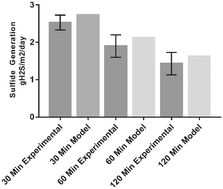Influence of pressure main pumping frequency on sulfide formation rates in sanitary sewers†
Abstract
Reductions to hydraulic flows in sewer networks resulting from water conservation and re-use strategies will change the operational behaviours of our existing sewer infrastructure. For intermittently flowing pressure mains, changes to the duration and frequency of pumping events effect in-sewer biological and chemical transformation processes including the generation of hydrogen sulfide. This study investigated the effect of the pumping frequency on average total hydrogen sulfide generation using a pilot scale experimental pressure main. In the experimental trials, doubling the pumping frequency from 30 minutes to 60 minutes and increasing the frequency further from 30 minutes to 120 minutes decreased the total daily sulfide generation by 25 ± 9% and 43 ± 11% respectively. The decrease in sulfide generation is due to sulfate diffusion limitations in the bulk liquid limiting its availability at the liquid – biofilm boundary. A computational temporal and spatial substrate diffusion model confirmed this hypothesis. The model also predicted a reduction in total sulfide generation with an increase in the hydraulic residence time in a pressure main. The results suggest sulfide production in a pressure main sewer could be substantially reduced either by manually reducing the operating frequency of the feeding pump or as a consequence of reduced influent flows.



 Please wait while we load your content...
Please wait while we load your content...